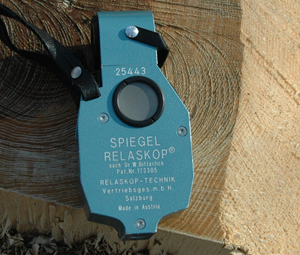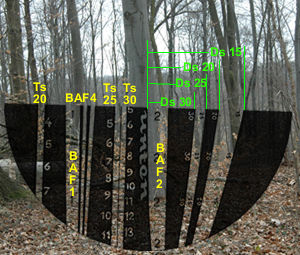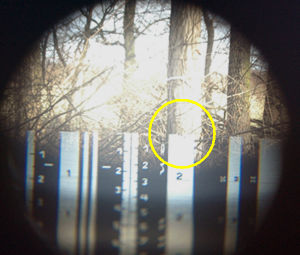Relascope
| Line 5: | Line 5: | ||
The Bitterlich relascope (Austrian designer [http://de.wikipedia.org/wiki/Walter_Bitterlich Walter Bitterlich]) is a multifunctional device that can be used to make an [[Bitterlich sampling|angle count sample]], estimate [[Bitterlich sampling|basal area]] depending on [[Bitterlich sampling|basal area factor]]. Additionally it can be used for height measurements by [[the trigonometric principle]] and to measure stem diameters in different heights to estimate form heights, form numbers and scape volumes for trees. | The Bitterlich relascope (Austrian designer [http://de.wikipedia.org/wiki/Walter_Bitterlich Walter Bitterlich]) is a multifunctional device that can be used to make an [[Bitterlich sampling|angle count sample]], estimate [[Bitterlich sampling|basal area]] depending on [[Bitterlich sampling|basal area factor]]. Additionally it can be used for height measurements by [[the trigonometric principle]] and to measure stem diameters in different heights to estimate form heights, form numbers and scape volumes for trees. | ||
| − | The relascope is constructed with a cylinder pendulum which enables [[slope correction]] for each measurement. Therefore you will have to press the button at the front of the device till the pendel stops moving (to be sure, that the slope is included) – disengage the button to lock the scales. The visual appearance while looking through the relascope is constructed as a horizontal sighting which appears in the half of the view. | + | The relascope is constructed with a cylinder pendulum which enables [[The trigonometric principle|slope correction]] for each measurement. Therefore you will have to press the button at the front of the device till the pendel stops moving (to be sure, that the slope is included) – disengage the button to lock the scales. The visual appearance while looking through the relascope is constructed as a horizontal sighting which appears in the half of the view. |
[[file: bitterlich01_portrait.jpg|thumb|300px|right|Bitterlich relascope]] | [[file: bitterlich01_portrait.jpg|thumb|300px|right|Bitterlich relascope]] | ||
[[file: bitterlich02_scales.jpg|thumb|300px|right|Scales implemented in the relascope]] | [[file: bitterlich02_scales.jpg|thumb|300px|right|Scales implemented in the relascope]] | ||
| Line 38: | Line 38: | ||
|angel count method for basal area factor =2 | |angel count method for basal area factor =2 | ||
|- | |- | ||
| − | |Ds 30 | + | |Ds 30 |
|distance scale for a 2m vertical base to measure horizontal distance of 30m | |distance scale for a 2m vertical base to measure horizontal distance of 30m | ||
|- | |- | ||
| − | |Ds 25 | + | |Ds 25 |
|distance scale for a 2m vertical base to measure horizontal distance of 25m | |distance scale for a 2m vertical base to measure horizontal distance of 25m | ||
|- | |- | ||
| − | |Ds 20 | + | |Ds 20 |
|distance scale for a 2m vertical base to measure horizontal distance of 20m | |distance scale for a 2m vertical base to measure horizontal distance of 20m | ||
|- | |- | ||
| − | |Ds 15 | + | |Ds 15 |
|distance scale for a 2m vertical base to measure horizontal distance of 15m | |distance scale for a 2m vertical base to measure horizontal distance of 15m | ||
|} | |} | ||
Revision as of 09:22, 4 May 2012
| sorry: |
This section is still under construction! This article was last modified on 05/4/2012. If you have comments please use the Discussion page or contribute to the article! |
Contents |
General description
The Bitterlich relascope (Austrian designer Walter Bitterlich) is a multifunctional device that can be used to make an angle count sample, estimate basal area depending on basal area factor. Additionally it can be used for height measurements by the trigonometric principle and to measure stem diameters in different heights to estimate form heights, form numbers and scape volumes for trees.
The relascope is constructed with a cylinder pendulum which enables slope correction for each measurement. Therefore you will have to press the button at the front of the device till the pendel stops moving (to be sure, that the slope is included) – disengage the button to lock the scales. The visual appearance while looking through the relascope is constructed as a horizontal sighting which appears in the half of the view.
If the light is too bright, you can darken the scales by moving up a small bar, which is assembled at the front of the device.
The following table gives a short description of the different scales implemented in the relascope.
| Scale name | description |
|---|---|
| Ts 20 (Tangent scale) | height measurement for distance 20m |
| BAF 1 (basal area factor 1) | angel count method for basal area factor =1 |
| BAF 4 (basal area factor 4) | angel count method for basal area factor =4 (BAF 1 combined with the following 4 relascope units) |
| Ts 25 (Tangent scale) | height measurement for distance 25m |
| Ts 30 (Tangent scale) | height measurement for distance 30m |
| BAF 2 (basal area factor 2) | angel count method for basal area factor =2 |
| Ds 30 | distance scale for a 2m vertical base to measure horizontal distance of 30m |
| Ds 25 | distance scale for a 2m vertical base to measure horizontal distance of 25m |
| Ds 20 | distance scale for a 2m vertical base to measure horizontal distance of 20m |
| Ds 15 | distance scale for a 2m vertical base to measure horizontal distance of 15m |
Handling
To do an angle count look through the device and press the lock button so that pendulum can work to do optically a slope correction. For a detailed description of the different scales and handling please see the manual. Below a few case examples are given doing an angle count.
| Advantages | Disadvantages |
|---|---|
| multifunctional device – parameters to describe the form single trees and also forest stand parameters can be derived | |
| slope correction implemented | |
| independence of power sources (no batteries needed) | in dark forest stand optical measurement is difficult, no digital storage of measurement results available. |
To measure large tree diameters in different heights, Bitterlich has developed a relascope with another broad scale view.
Here a scale is implemented to measure slope in degrees and percentage, and scales for basal area factors up to 11.
Applications



